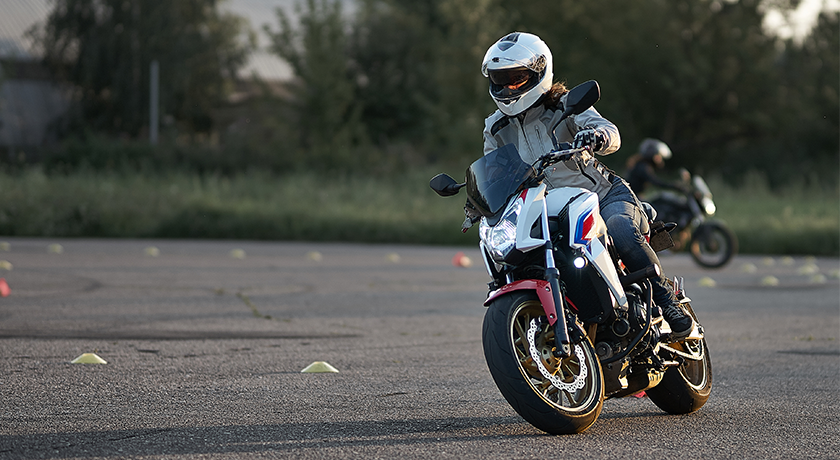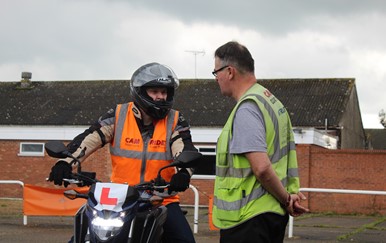I think it goes without saying motorcycle licencing can be tricky to grasp, especially when you are a new or young rider wanting to know what bikes you can ride as you work your way towards your full licence.
In this blog, we are going to be running through all of the licence types, as well as what is required to achieve them and what bikes you will be allowed to ride once you have obtained each licence.
Let’s get into it!

Motorcycle Licencing Types | Requirements
Provisional Licence
Before you begin your bike licence journey, you must apply for a provisional licence. You can apply for your provisional licence three months before your 16th birthday through the Government website for £34.
Once your provisional has arrived in the post, you can then look to take your CBT (Compulsory Basic Training).
Taking your CBT (Compulsory Basic Training)

As we mentioned above, once you have received your provisional licence, you can book your CBT. For those of you who are unsure of what a CBT is, in brief, it is a day-long course that covers all of the basics (theory and practical) knowledge of riding a motorcycle you will need to do before you get out on public UK roads.
After you have passed your CBT
After your CBT has been completed and you have received a CBT certificate (also known as a ‘DL196 certificate’), you will then be allowed to either ride a maximum of a 50cc (4kW) if you are 16, or if you are 17 or older you can ride a 125cc (11kW) scooter or motorcycle with L plates.
You will probably notice most people on small capacity bikes such as 50cc and 125cc ride theirs on a CBT and display L plates. Though there are options to get a licence just for smaller capacity bikes which I will delve onto next, it is fair to say this is rather uncommon. As most will wait and go for a licence which will allow a larger engine size / power output.
*Please note: Your CBT certificate will only last for two years, so once this expires you will either have to retake your CBT, or transition to getting a licence before your CBT expires!
AM Licence

If you are 16 years of age and have passed your CBT, you can then choose whether or not you wish to obtain your AM licence…
How do I obtain an AM licence?
To get your AM licence, you will need to:
- Be at least 16 years old
- Take & Pass your CBT
- Pass both your Theory & Practical on a 50cc moped/scooter
Obtaining your AM Licence and UK law
After passing your theory and practical testing, in line with the current UK laws, the Government states that when riding on an AM licence you can:
- Ride a <50cc moped/scooter, capable of producing speeds of up to 28mph
- Ride without L plates displayed on your bike
- You may carry a passenger (if you wish, and it is safe to do so)
A1 Licence

As you turn 17, you will be permitted to try for your A1 licence. Though again just like AM Licence this isn’t one which you see a lot of.
A1 Licence/125cc Motorcycle Licencing Requirements:
- Be at least 17 years of age
- Have completed your CBT and hold a valid certificate
- Passed your Theory & Practical test on a 125cc bike
What cc bike can I ride on an A1 Licence?
Once your A1 licence has been obtained, you will legally be allowed to ride a motorbike/scooter with a <125cc engine, that has a maximum output power of 11kW and/or a power-to-weight ratio of more than 0.1 kW per kg.
A1 Licence/125cc motorbike laws
Aside from being allowed to ride a bike with a maximum displacement of 125cc, other benefits of passing your A1 Licence tests include:
- Can ride without L Plates
- Allowed to carry a passenger
- Permitted to ride on motorways
A2 Licence

A2 Licence Restrictions and UK Law
In line with UK Government licencing laws, once you have passed the relevant tests required for your A2 licence, you will then be allowed to:
- Ride a motorbike/scooter with a Power output of 35kW (47bhp)
- Ride more powerful bikes that have restrictors fitted
- Ride without L Plates
- Carry a passenger
- Ride on Motorways
Obtaining your A2 Licence:
There are two routes you can take to obtain your A2 licence, these are:
Direct Access (DAS)
The direct access option is for those who are 19 years old and over and have no interest in getting their A1 or AM licence and just get their A2.
First things first, if you opt to take this route you will need to complete your CBT, as well as pass both your motorbike theory and practical tests on an A2 bike with at least a 395cc engine, and a power output of between 20kW and 35kW.
Progressive Route
On the other hand, if you choose to go down the progressive route, you will need to have been riding on your A1 licence for at least 2 years before you can retake your practical motorcycle test on a bike with a power output minimum of 395cc.
A Licence

Similar to achieving your A2 licence, there are two ways in which you can go about getting your A Licence - also known as your full motorcycle licence!
Direct Access (DAS)
The Direct Access route to getting your A Licence is a three-step process. Firstly you will need to be a minimum of 24 years old, then you will also need to complete your CBT (if you have any questions on this, please head over to our full CBT guide), and then go on to passing your practical and theory test on a bike > at least 595cc (54bhp) motorcycle.
If you are new to riding bikes it is recommended, however, that you get some practice on an an A1 or A2 licence bike first, just to get yourself used to the basics and riding as a whole before moving onto a much more powerful machine. Your motorcycle training school will likely go through this all with you to build up the right plan of action for your experience and ability.
Progressive Route:
Again, similar to the progressive route from A1 to your A2, to retake your motorcycle practical tests, you will need to have been riding on your A2 licence for a minimum of two years.
One of the biggest differences you face getting your A Licence through the progressive route is that you only have to be 21 years of age to pass your practical test instead of waiting until you are 24.
What’s Next: Getting your A Licence
Once you have passed your practical and theory tests, you will then have obtained your full motorbike A Licence and therefore will be allowed to ride any output motorcycle you wish without any restrictions.
Get Insured
Last but not least, after you have obtained your full bike licence and bought your very first bike, you will need to insure it!
If you are in need of motorbike insurance, make sure to get a quote direct with Lexham.










